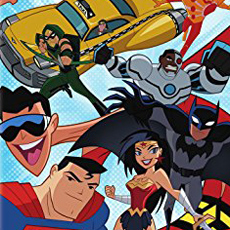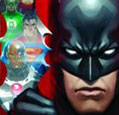Warner Bros. (2008), Warner Home Video (February 26, 2008), 2 discs, 75 mins plus supplements, 16:9 ratio, Dolby Digital 5.1, Rated PG-13, Retail: $24.98
Storyboard:
During the Cold War, suspicion is replaced by hope as the Justice League is born.
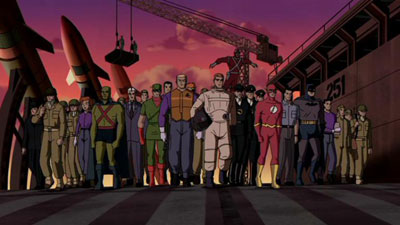
The Sweatbox Review:
Darwyn Cooke’s graphic novel DC: The New Frontier first appeared as a series of six comic books in 2003 and 2004. Its sense of graphic design was an immediate eye-catcher, while it’s story guaranteed that the comic would become considered a modern classic or, for those that hate that term, at least a fine representative of what modern comics have to offer. It only gathered more esteem by winning Harvey and Eisner awards. It was next collected as a set of two paperbacks, and finally as a huge slipcased hardcover. No matter how one first reads it, though, it is a story that cannot be easily forgotten. Its sprawling narrative covers the 1950s era of the Cold War, where Communist paranoia led not only to the blacklisting of many prominent individuals in America, but in the DC Universe also led to the disbanding of the Justice Society Of America. The United States at that time, or at least Senator Joseph McCarthy as well as those who sat on the House Committee On Un-American Activities, had little use for justice, it seemed. Instead, these people bred mistrust and fear at a time that the country was otherwise enjoying a period of prosperity and new development. If America had no use for the justice the heroes sought, then why should the heroes continue fighting for America?

DC: The New Frontier attempted to answer that question, while weaving a tapestry that included important events leading up to the formation of the Justice League Of America. During the course of the graphic novel, it is not immediately clear how all the various plot seeds relate, but in the end there is a glorious coming together of the disparate threads as the heroes are forced to stand up not only for their country but their world. The graphic novel also focused on the efforts of non-powered heroes of the real world type, emphasizing that we are all in this together. The men in masks are just men after all, blessed with wonderful abilities certainly, but just as interested in the human race’s survival as anyone. The inspiration given by heroes of all types coincides with the popularity of America’s great optimist, President John F. Kennedy. It is his 1960 acceptance speech, referencing a “new frontier of unfulfilled hopes and dreams” that gave the story its name.
Despite the popularity of the graphic novel, few would have suspected that Warner Bros. would ever consider adapting it into a direct-to-video movie. Though the story’s quality is high, there are many things about it that could be considered non-commercial. First and foremost, it is a period piece, which makes it unlike any other superhero story that has been brought into the animated world. The scope of the story could also be considered daunting, given a huge cast of characters and a timeline that encompasses a decade. Nevertheless, some executive at Warner obviously thought highly enough of the concept that the project was greenlit. The fact that the story was allowed to be kept in the 1950s may have surprised the producers, but it should not have; the time period is so essential to the story being told that there is no way it could work in another era without changing the entire point of it.
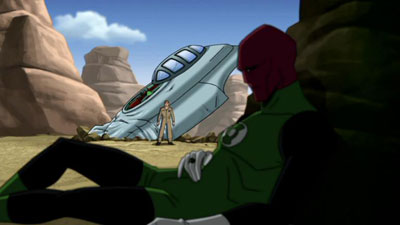
In fact, as it turned out, I had an even clearer appreciation for the intent of the story after watching the animated film than I did after reading the graphic novel. For sure, the book made many individual points, but the lean animation script, which pared down the story to eliminate many subplots and scenes, keeps one main thing in clear focus. This story is about America moving on past the darkness of McCarthyism and embracing a new spirit of cooperation and fairness. It takes the concept from a story published in 1979 (Adventure Comics #466), where the Justice Society disbanded after being brought to the HUAC-inspired Joint Un-American Activities Committee, and attempts to reconcile it with the advent of the Justice League a few years later. Current DC publisher Paul Levitz, who wrote that Adventure Comics story, is likely amazed that such a project as The New Frontier came to be based off of that one short story— a story that was not even featured on the cover! After all, at that time in DC continuity, the JSA and JLA inhabited different alternate Earths; and nowadays, the JLA is far too young to have been formed at the close of the 1950s. It took a special project like this, which simultaneously eschews and embraces continuity, to examine the relationship between the two teams in such a unique way, with a true historical perspective. Actually, it’s a bloody brilliant idea.
Writer Stan Berkowitz was given the task of developing the story for animation. It is clear that he had to choose what to make the story about, given the many themes Cooke explored, but I think he did a great job of diluting the story to its basic essence. Gone is the extended prologue with the militaristic team The Losers, as is the explanation of Dinosaur Island. We also don’t get to see much of the cartoon versions of the Challengers Of The Unknown or The Suicide Squad, but even as it does rob the story of some of its complexity, it does allow the parts that remain to shine. Actually, the original story was not solely about the Justice league, but branding it as a JLA story does make it more commercial for the mass public, as well as describing the focus of the animated version. And, if you watch the movie closely, you will see that very little of the original story has been left out entirely. Whether through newspaper clippings, television clips, or voiced references, most of Cooke’s story is at least alluded to.
The animated movie begins with introducing the “villain” of the piece, The Centre (Canadian Darwyn Cooke used the British spelling), an ages-old entity that lives on earth and is deciding to eradicate mankind. His origin and desires are spelled out in the final work of a Seuss-like author/cartoonist. The prologue then gives way to a title sequence that is styled after the great Saul Bass movie posters and titles sequences of the 1950s and onward. The Darwyn Cooke’s New Frontier iconography is perfectly blended with the Bass approach, and covers much of the ground that has otherwise been cut from the movie version of the story, including the disbanding of the Justice Society and the US government’s mystery men hunt.
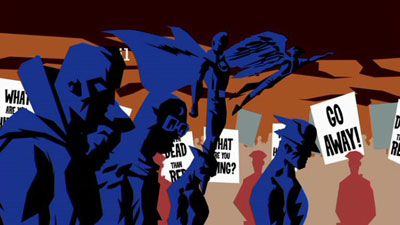
The story then proceeds with the introduction of Hal Jordan, fighter pilot, at the end of the Korean War. Meanwhile, J’onn J’onnz arrives on earth from Mars, which itself sets off a chain of events that influences US military policy as well as the maturation of Hal Jordan and his recruitment as a Green Lantern. Superman and Wonder Woman clash over ideology in Indo-China, as Superman is portrayed as being loyal but naïve. In a terrific little scene not seen in the book, Lois Lane later tells Superman that the country is basically screwed up, and the people and their heroes need a leader to bring them to where they need to be. The weight on Superman’s shoulders in this scene is plain, as the humble farm boy from Kansas is clearly uncertain of how to achieve his destiny.
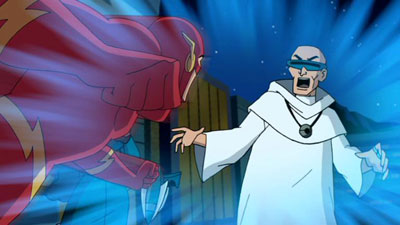
The narrative continues with The Flash taking on Captain Cold in Vegas. J’onn becomes a police detective and meets Batman as they take on a cult. Hal, fresh out of psychiatric treatment, gets a job at Ferris Aircraft. The storybook seen in the prologue re-enters the story as J’onn and Batman investigate strange psychic phenomena. The Flash retires in the face of government persecution, and J’onn decides to leave Earth since he sees little hope in the hearts of humanity… until he meets a government spook whose tough exterior belies a noble soul. As events swirl and stories converge, the heroes rise up to aid the world in its hour of need, and America is lifted out of its decade-long struggle with its dark side. In addition to the beginning of JFK’s tenure of president, the Justice League gives the country hope that it can use optimism and cooperation to reach its true potential and move past the mistakes of its past.

That is some pretty heavy material for a superhero story, and precisely why I love it so much. In truth, I felt the ending of the both the graphic novel and therefore the movie version failed to provide the final shining moment the story demanded, but so much is achieved here that both still stand tall as positive achievements. It would not have taken much, though, to propel the story to even greater emotional heights. Just as Berkowitz improved on the graphic novel by giving Lois and Superman as extra scene, I wish that there could have been more of a payoff added to the dénouement. The ending is far from anticlimactic, as it is just as action-packed and well animated as any Justice League TV series epic, but such a big story could have benefited from a few more character touches at the end. In fact, I think that just one glimpse at Lois’s expression when Superman takes control of the situation at the film’s climax would have paid off immensely. Or, how about the reaction of the common man, welcoming a new age of heroism? Either of these could have been achieved with second-long still shots, and could have brought home the points of the story just that much more strongly. Or maybe I just like my melodrama.
I do believe that this is the type of film that will grow stronger with each successive viewing, as one pays less attention to such things as the beautiful design work, the pros and cons of the story adaptation, and the thrill of seeing Silver Age (or Golden Age)-styled DC characters in animation— and becomes more swept up in the themes of the story. (Incidentally, those thrills include seeing the Fleischer cartoon Superman live again, a Batman in short gloves and long ears, and Barry Allen’s Flash costume erupting out of his ring.) Cooke, a non-American himself but obviously loving the ideals of America, made some strong political points in his graphic novel, and the parallels between the 1950s and the more recent past can not be ignored. In fact, these parallels may become even more obvious a few years from now, when the early days of the 21st century can be viewed with greater perspective.
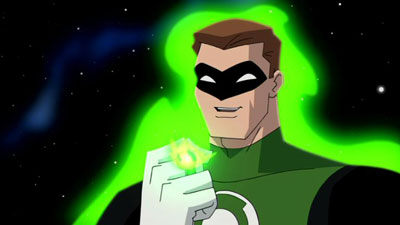
One thing I love about watching direct-to-video features is the use of hand-drawn animation. The animation here is quite wonderful, within the boundaries of its budget. Digital effects are used minimally, primarily with jet airplanes, in order to not make the film look overly modern. There are small touches that put this a step above the usual TV fair, such as the fact that the whites of people’s eyes are actually white, not-flesh-colored. Note that this movie earns its PG-13 rating with some gore, mild swearing, and obviously its mature themes, including the reason why Wonder Woman allows a group of women to slaughter their captors.
Is This Thing Loaded?
The first disc begins with a preview of Appleseed: Ex Machina, but the juicy stuff begins with the featurette Superheroes United: The Complete Justice League History (41:05), a surprisingly in-depth (though far from complete) look at the DC Comics team. Such comic book people as Roy Thomas, Denny O’Neil, Marv Wolfman, Len Wein, and Paul Levitz appear, as does Stan Lee, who seems a bit out of place in a DC Comics history. Nevertheless, this is a great piece for anyone who has ever enjoyed a JLA story. Darwyn Cooke appears during a roll call of the main characters from the team, offering welcome comments on how they were depicted in New Frontier. It’s good stuff, and all presented in anamorphic widescreen.
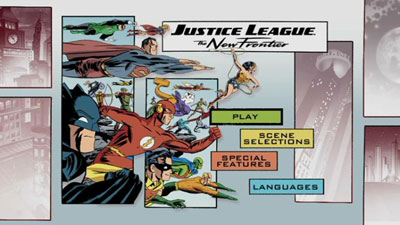
Sneak Peek: Batman Gotham Knight (10:09) gives a tantalizing glimpse at the developing next entry in the DC Universe line of animated movies. Again, numerous DC Comics types appear to discuss the character, as well as this anime movie. The clips from the film look very nice.
Two Audio Commentaries appear with Justice League: The New Frontier. The first is with the filmmakers (including director David Bullock, executive producer Bruce Timm, voice director Andrea Romano, supervising producer Michael Goguen, Gregory Noveck of DC Comics, and writer Stan Berkowitz). They provide good insight on how they went about adapting such an immense graphic novel, particularly one with a mosaic type of plot that is structured more like a novel than a movie. There were hard choices to make during the entire process, but they do mention Cooke’s assistance in helping them to accept the inevitability of changes. Cooke even storyboarded sequences that were unique to the film. (He was previously an artist on some of the DC animated series.) Cooke has the whole second commentary to himself, where he entertainingly shares his views of the project. Both commentaries are definitely worth listening to.
Trailers on Disc One include those for Superman: Doomsday, August Rush, The King Of Kong, and Torchwood.
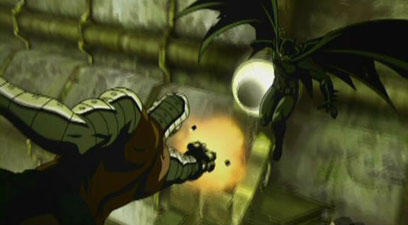
Disc Two has mostly fluff, so don’t feel bad if someone only gave you the single disc version as a gift. The Legion Of Doom: The Pathology Of A Supervillain (33:58) is a lengthy look at the bad guys of the DC Universe, but it really has no place on this set. The only supervillain making any significant appearance in The New Frontier is Captain Cold, so those interested in just the movie will get almost nothing out of this. The only NF revelation is Cooke mentioning that the Centre was his “obvious” metaphor for communism, even though most have not seemed to catch on. For DC buffs, it is fun to see this featurette for its examination of the evolution of the supervillain through the various ages of superhero comic books.
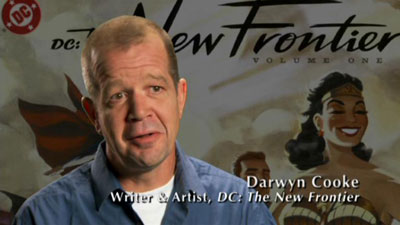
Comic Book Commentary: Homage To The New Frontier (10:14) is the one essential extra to appear on the second disc. This is where Darwyn Cooke goes through the various omissions and changes to the story that separate the movie from the comic. Of course, he does the same in his commentary, so this featurette is somewhat redundant. The rest of this disc is set aside for Bonus Episodes from Justice League Unlimited. These were supposedly selected by Bruce Timm as his “favorites,” but in fact each episode has ties to The New Frontier. Dark Heart sees the League enlist Ray Palmer, The Atom, to fight an immense threat, similar to what is seen of his appearance in the movie. To Another Shore brings King Faraday to the show; Faraday also plays an important role in New Frontier. Task Force X features Rick Flag and the Suicide Squad; though the Squad is largely absent from the movie, Flag does play a leading role in the New Frontier cartoon adaptation. These episodes are presented in the 4:3 ratio, unlike the widescreen DVD sets.
Case Study:
Both the single and two-disc versions of the DVD feature the artwork of Darwyn Cooke, in drawn and painted styles, respectively. The two-disc set is in a standard keepcase with a swinging tray and four-page advertising booklet (the New Frontier action figures do look nice). The two-disc set also has an identical slipcover with the title embossed.
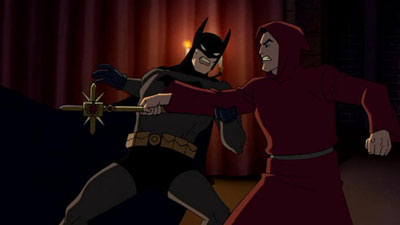
Ink And Paint:
The 16:9 image is naturally pristine, owing to modern computer aided post-production. No blemishes intrude on one’s enjoyment, and the compression work is nearly flawless. There are just a couple of instances of minor aliasing, but otherwise this is a great looking DVD transfer that nicely captures the rich color palette of the film that at times gloriously accentuates the fine graphic design, particularly the opening titles and closing sequence.
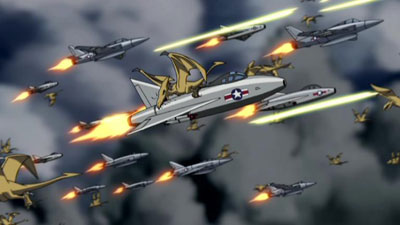
Scratch Tracks:
The 5.1 track is nice to see, but less impressive to hear. It’s certainly better than what you’ll find while watching cable, but despite the use of a full surround mix, it doesn’t feel quite as impressive as it could have. When sound does enter the rear speakers, it just serves to remind you that they haven’t been used more, and the low end of the sound field doesn’t live up to its potential either. I’m sounding a little harsh, though; overall this is a pleasing mix, just not what it could have been. There is also a Portuguese language track provided, as well as English and Portuguese subtitles.
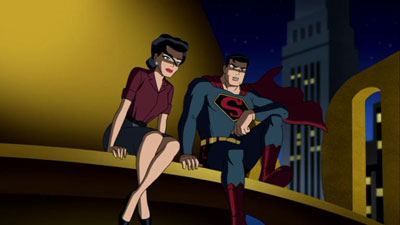
Mention should be made of the cast in this section. David Boreanaz properly gets first billing, as he carries the most important role of Hal Jordan. His Jordan is human, cocky, and believable. Neil Patrick Harris does a nice Flash, at once noble and overwhelmed by his place among the heroes. Kyle MacLachlan does an upstanding Superman who is just learning how to lead, and Jeremy Sisto does a nice, grumbly Batman. Lucy Lawless’ voice is a bit too raspy for my liking as Wonder Woman, and she sometimes sounds to be doing more reciting than acting. Kyra Sedgewick and Brooke Shields do some of the best work here, as Lois Lane and Carol Ferris, who do much to influence the choices of their leading men. Miguel Ferrer gives probably my favorite performance, as the conflicted Martian Manhunter, the alien who wants to believe in America even when America doesn’t believe in itself.
Final Cut:
Both the graphic novel and the cartoon adaptation feature a tremendously interesting conceit of tying together real-world and comic book events during the 1950s. The endings for both could have been stronger, if only to give the whole story a proper epic feel that the earlier events seemed to be leading to. Regardless, both versions provide good entertainment and something to think about. Both DVD editions have some great bonus features, though the second disc of the two-disc set could have been better utilized if it had had more that pertained to the movie, such as artwork or animatics, or something with the voice actors (who were shown on the promo for the movie which appeared on so many prior DVDs). The bottom line, however, is that this is a film that will likely grow in stature over time and in subsequent viewings, as its themes become more important than its details.
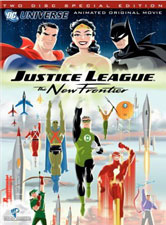 | ||
 |







